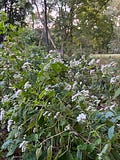My husband and I have let our backyard re-wild which means we don’t mow it and we see what comes up. When we first started this project a few years ago, we dreamed that a beautiful meadow would develop with a vibrant mix of colorful wildflowers. That’s not what happened. We do have some pretty plants—swamp rose mallow, orange jewelweed, and blue mist flower. But these small patches of wildflowers are overrun by large swatches of invasive species, mugwort and porcelain berry vines, and quick-spreading native plants that look like weeds.
Currently, our backyard is covered in White Snakeroot*, a 3-5 foot tall perennial that blooms from July to October with fluffy clumps of white flowers. While these plants aren’t ugly, what bums my head is their pervasiveness, crowding out any other plant that might grow. This makes me dislike the plant, and when the wind blows the tiny white fluffs into the air, I don’t think “Oh that’s pretty,” I think “Ugh, it’s going to spread more!”
So imagine my surprise when I visited the beautiful Blithewood Garden at Bard College in Annadale-on-Hudson, NY, and saw, in this walled classic Italianate garden, White Snakeroot. It even had its own plaque telling visitors its name, as if it were some fancy schmancy plant, as if it weren’t just a weed!
“One man’s garbage is another man’s treasure,” is an oft-repeated cliché that could apply to this situation but that’s not the lesson here.
For me, my feelings towards this scrappy plant were a clear symptom of my disease of alcoholism, and what my sponsor always tells me is also a disease of perception.
What does she mean by “disease of perception?” Well, my alcoholism often skews my view of reality. So something I think, or even insist is true, may not be.
For example, I think my friend is mad at me because she is not returning my phone call. I begin to search my brain for reasons she might be mad. Did she take offense to the joke I made? Was she angry I had to cancel a plan? Eventually the voices in my head land on, she just doesn’t like you because you are unloveable.
When my friend calls me back and explains the reason she didn’t return my phone call right away was because x,y,z, even though her reasoning makes sense, that feeling of “I’m unloveable” lingers. My disease looks for proof that this feeling is true: I didn’t get a lot of likes on my social media post, I wasn’t invited on that moms’ outing, or my father has moved across the country to get away from me. Down the self-pity spiral, I go. Wee!
This “evidence” I have accumulated as proof that I’m unlovable is based on a false narrative. But I cannot see that false narrative because of my disease. I need to talk to my sponsor or another alcoholic to be shown a different reality. Only then can I begin to quiet the chorus of negativity in my head.
In my skewed thinking, a plant that grows so easily in my backyard cannot be considered a beautiful native plant that should be nurtured for its benefit to bees, moths, and butterflies. No, if it’s in my yard and happily spreading, it must be an unwanted weed.
In order to readjust my negative perception, I needed to be shown a different reality of White Snakeroot, one that involved a plaque.
I love it when my disease of perception is so obvious. Sometimes that’s not the case. Like my alcoholism, it can be “cunning, baffling, and powerful.” The only way to keep my reality on track is to be honest with another alcoholic.
Now when I look out my window at the large swatch of White Snakeroot, I’m reminded to call my sponsor!
*P.S. - In researching White Snakeroot, I’ve learned it’s poisonous so don’t eat it!





Lovely insights. Sounds like it's time to get your backyard some plaques!
I sooo love you. Liz Jannuzzi!